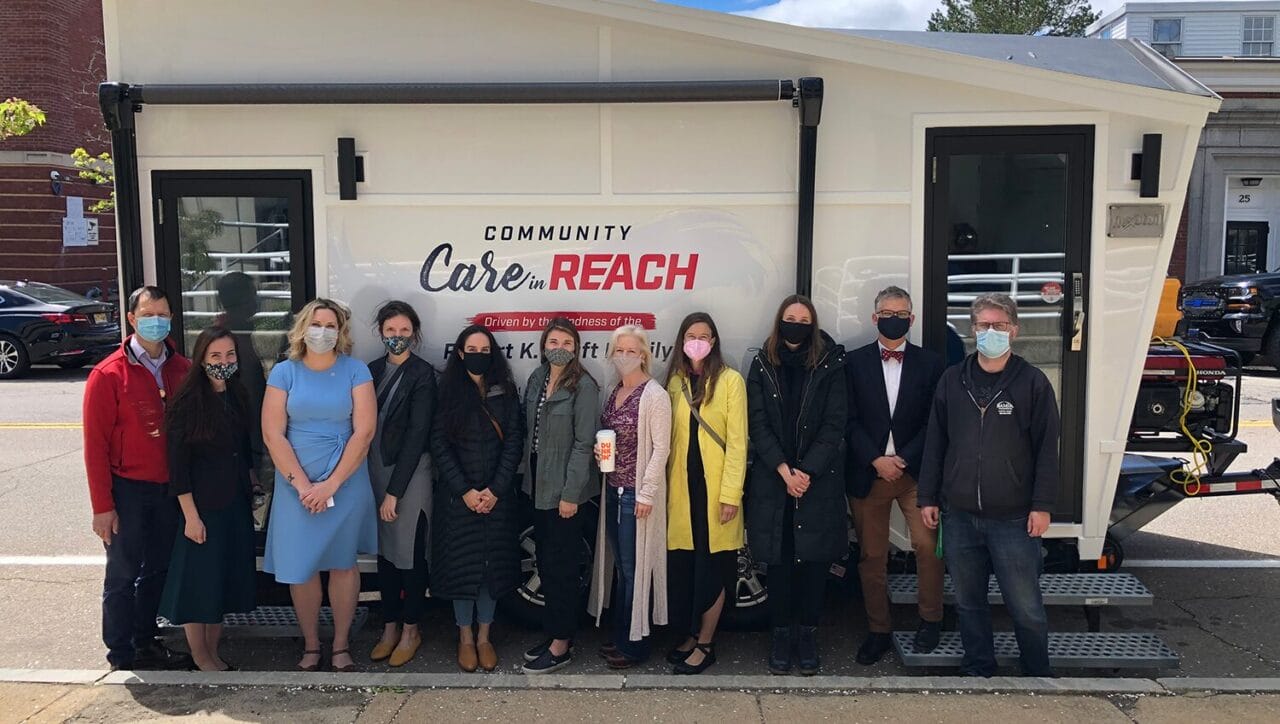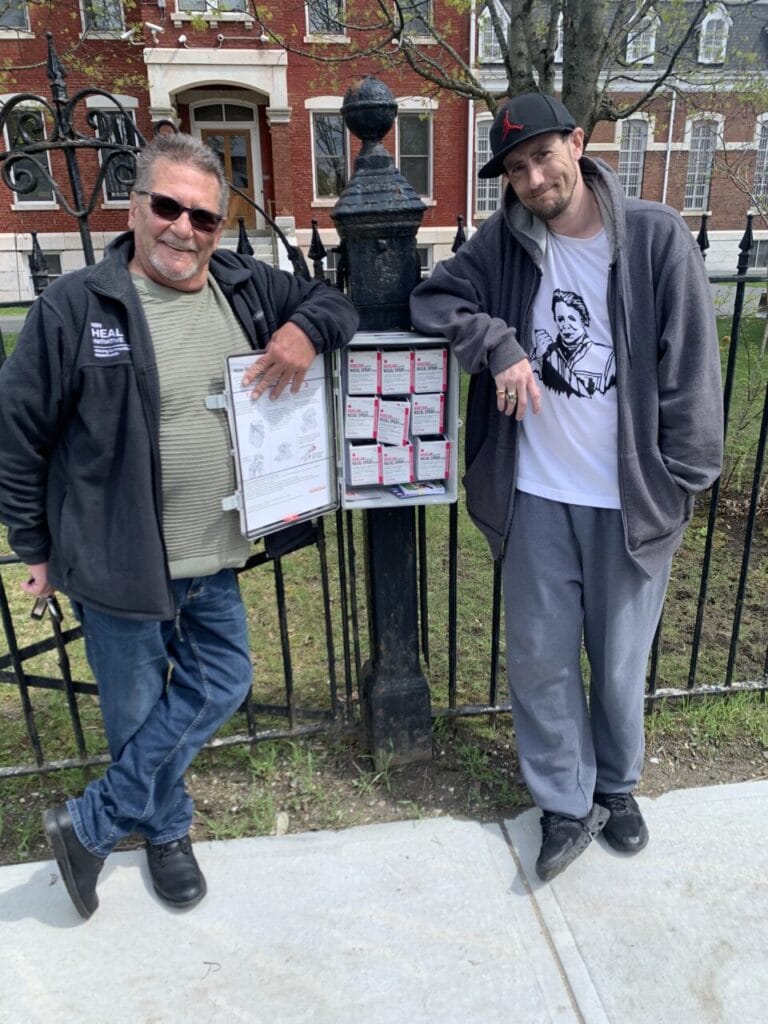"Remarkable" Effort to Reduce Opioid Overdose Deaths Is a Beacon for the Future
August 29, 2024

Boston Medical Center
Members of the HEALing Communities Study team stand in front of one of their mobile clinics.
BMC led Massachusetts in the NIH's HEALing Communities Study, and the unprecedented community collaboration was key to helping people with opioid use disorder access effective treatment.
The Massachusetts Department of Public Health reported in June that opioid-related overdose deaths in the state decreased by 10% in 2023, which is the largest single-year decline since 2009-2010. And while this data is promising, experts note that there is still a lot of work to be done to save lives. Key to that effort is dedicated, community-level initiatives—much like those implemented by the HEALing Communities Study (HCS).
HEALing Communities is a National Institute of Health (NIH) study designed as a bold effort to speed scientific solutions to stem the national opioid crisis. The study was implemented in January 2020 across four states—Massachusetts, Kentucky, Ohio, and New York. Boston Medical Center (BMC) spearheaded the study in Massachusetts, leading a massive effort to help people living with opioid use disorder access trusted, effective treatment more easily in their communities. Communities in these states implemented evidence-based practices, practices that have already been tested and found to be effective in reducing rates of opioid-related overdose deaths but, for many varied reasons, have not seen a high level of uptake.
Jeffrey Samet, MD, MA, MPH, a BMC primary care physician and the lead investigator for Massachusetts’ HEALing Communities Study, and Carly Bridden, the study project manager, are encouraged by its successes and hope that everyone’s work will lay the groundwork to ensure local community access to evidence-based interventions. In Massachusetts, teams implemented innovative naloxone distribution programs, stood up new addiction consult services, opened bridge clinics, and addressed treatment deserts with opioid treatment programs and mobile clinics. It’s all part of an effort that Samet calls “remarkable.”
HealthCity spoke with Samet and Bridden about the study, the absolute necessity of community collaboration, and successes that we can use to move forward.
HealthCity: We’ve seen the overall HEALing Community Study headlines, but can you talk more specifically about the study’s roll-out and impact in Massachusetts?
Jeffrey Samet, MD, MA, MPH: In our state, 615 programs and initiatives were implemented over the course of the study—and a lot of them were really complicated. That’s just remarkable. Two opioid treatment programs were set up in communities, one of which had never had it before. Those are unique Massachusetts stories.
“Communities were able to speak with a united voice to effect change. It’s much harder to ignore a coalition that’s coming with data than it is to ignore a single person.”
A really important element is that we were able to stand up novel community outreach initiatives. For example, we did peer stipending, in which programs worked with people with substance use disorder to distribute naloxone in their networks. We also saw how well mobile units worked in HIV care, so we co-funded and collaborated on these clinic vans that offered medications, harm reduction services, and connections to recovery coaching. People working on those mobile units were funded by the HEALing Communities Study.
HC: This is an immense amount of work implementing hundreds of programs. Can you talk about the partnerships and collaboration that helped facilitate the study’s work here in Massachusetts?
JS: Upon ending the study, we went into each community and had an end-of-study event. We asked community members what they found most memorable about the experience. The highest on the list was that while people in the room may have known of each other before the study, they had not worked together. The HEALing Communities interventions created a means by which they came together, and everyone really got to know each other. They together looked at substance use disorder data in their community and were able to make decisions based on evidence as to what would work best for them, for their cities and towns. The collaboration was quite notable and a lasting impact of this study.
HC: A key part of that collaboration seems to be the local community coalition. The study gathered local community leaders from across specialties and industries as part of choosing and implementing initiatives for their specific city or town. How did the coalition work?
JS: There was power in the coalition. Communities were able to speak with a united voice to effect change. It’s much harder to ignore a coalition that’s coming with data than it is to ignore a single person.
Carly Bridden: To make up the community coalitions, we would always ask, who is at the table and who is not? We wanted people who had been left out of the decision-making in the past to have a seat at the table. It was very comprehensive. We focused on reaching out to clinicians, nurses, and other treatment providers at community health centers, hospitals, and local behavioral health clinics as well as public health and harm reduction groups. Then, we included the mayor’s office or other local municipal groups, such as the health department or board of health. In some cases, we worked with local religious organizations. Local police and fire departments were often involved, and they were important for bringing data to the table—and it was key that we didn’t work in silos.

JS: A really prominent voice in the coalitions were people with lived experience and their parents and families. People who were in recovery or actively using substances often wanted to be involved, and they were important voices to have at the table.
HC: You talked about looking at who is offered a seat at the table and who is not. Can you talk about the impact of having people with lived experience of substance use disorder as important voices in the coalition? What did that bring to the table?
JS: It brought reality, a concreteness, to what we’re doing. We’re working to decrease overdose deaths. Many people had lost loved ones or almost lost loved ones to overdose, and so it became really clear and human what our purpose was.
It also brought perspective. We needed pragmatic solutions that people would really engage with. With our peer stipending program, the success and the key point was getting naloxone to people who were actually using drugs, especially those who were not as connected to the health system. That was something that people with lived experience at the table of the coalition were saying.
“You’ll often hear people say that addiction is the opposite of connection. I think that through this study, connections were truly made in a lot of communities.”
CB: You’ll often hear people say that addiction is the opposite of connection. I think that through this study, connections were truly made in a lot of communities. Also, a lot of the funding went to personnel to help continue to connect people—a lot of recovery coaches, navigators, and other types of roles. There was a real human touch, a human connection that people were getting through these programs.
HC: What are your key takeaways or most memorable experiences from the study?
CB: For me, it was the recognition that there are so many different stakeholders doing this type of work, even in the smallest towns or most rural areas. But they weren’t always connected. So, this infusion of staff and money really helped bring people together and get things done.
JS: I’ve been working in the addiction medicine field for 30-plus years, and we’ve developed innovative, effective approaches that we’ve been using at Boston Medical Center and sharing over this period of time with other academic medical centers. But what we saw so vividly when we actually got out into the communities was that these evidence-based practices weren’t being adopted. They just weren’t happening. So, going into the communities, having those conversations, and putting in place opportunities to implement programs and initiatives was so impactful. Six communities created new hospital addiction consult services, which was mind-blowing. Hospitals also found a way to keep many of those initiatives continuing even after the study ended. With opioid overdose settlement money, there’s a chance to invest in the future of programs like these.
*This interview was edited and condensed for length and clarity


